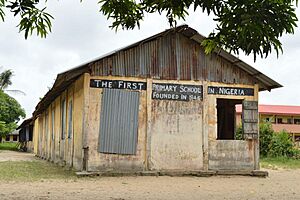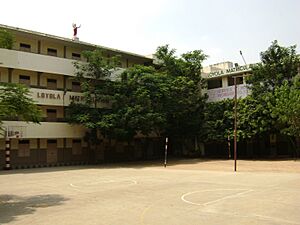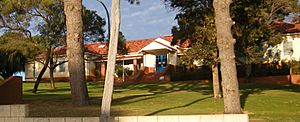School facts for kids
A school is a place where students go to learn. It's an educational institution designed to help students learn from teachers. Most countries have a system of formal education, and sometimes it's even required by law for children to attend. In these systems, students move through different levels of schools. These schools can be run by the government or by private groups.
The names for schools can be different in various countries. But generally, there's primary school for younger children and secondary school for teenagers. After secondary school, many students go to a university college or university for higher education.
Before primary school, very young children (usually ages 3–5) might go to Kindergarten or preschool. After secondary school, options include vocational school (for job skills), college, or seminary (for religious studies). Some schools focus on one specific area, like a school for dance or economics. There are also Alternative schools that offer different ways of learning.
Schools not run by the government are called private schools. They might be needed if government schools don't offer specific types of education. Some private schools are religious, like Christian schools, madrasas (Islamic schools), or yeshivas (Jewish schools). Other private schools might offer a higher standard of education or focus on special achievements. For adults, there are schools for corporate training, military education and training, and business schools.
Some people have concerns about the school system. They might say it doesn't always prepare students well for their future lives. They also suggest that schools sometimes limit creativity by telling students exactly what to do and how. Using things like grades and homework might also reduce a child's natural curiosity and desire to learn.
In homeschooling and distance education, learning happens outside a traditional school building. This can be at home or through a virtual school online. Schools are organized in different ways, like having separate departments or smaller learning groups.
Contents
What Does "School" Mean?
The word school comes from the Greek word scholē. This word originally meant "leisure" or "free time." Later, it came to mean "a group of people who are given lectures" or "a place of learning."
How Schools Started and Grew
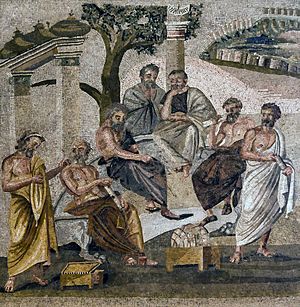
The idea of bringing students together in one place to learn has been around for a very long time. Formal schools existed in ancient Greece (like Plato's Academy), ancient Rome, ancient India (called Gurukuls), and ancient China. The Byzantine Empire had a strong school system starting in 425 AD. This system helped make sure many citizens, including soldiers, had at least a basic education.
In Western Europe, many cathedral schools were started in the Early Middle Ages. These schools trained future religious leaders and administrators. Some of the oldest schools still running today include The King's School, Canterbury (started 597 CE). Starting in the 5th century CE, monastic schools also appeared, teaching both religious and everyday subjects.
In Europe, universities began in the 12th century. For a long time, the main goal of schools (not universities) was to teach Latin. This is why some schools were called grammar schools. Over time, school lessons grew to include reading and writing in local languages, as well as technical, artistic, scientific, and practical subjects.
Going to school became required in parts of Europe during the 18th century. For example, in Denmark-Norway, this started in 1739–1741 to help more people learn to read and write. Many early public schools in the United States were one-room schools. A single teacher taught all ages of boys and girls in the same room. By the 1920s, these one-room schools started to combine into larger buildings with many classrooms. School buses then helped students get to these bigger schools.
Islam also developed its own school system. Learning was very important, so a structured way of teaching was needed. At first, mosques were used for both religious activities and learning. But by the 9th century, the madrassa was introduced. This was a school built separately from the mosque, like al-Qarawiyyin, founded in 859 CE. These were some of the first public school systems.
Under the Ottomans, cities like Bursa and Edirne became major learning centers. The Ottoman system of Külliye was a complex of buildings that included a mosque, hospital, madrassa, and public kitchens. This made education more available to everyone by offering free meals, healthcare, and sometimes even free places to stay.
Different Names for Schools Around the World
The word "school" and the names for different education levels can change from country to country.
Schools in the United Kingdom and Commonwealth Countries
In the United Kingdom, "school" usually means places for learning before university. These include pre-schools or nursery schools, primary schools, and secondary schools. Most schools in the UK are funded by the public and are free to attend. These are called state schools. There are also private schools that charge fees. Some very old and famous private schools are called public schools, which can be confusing because in North America, a "public school" is usually free and government-funded.
Many countries in the Commonwealth of Nations, like Australia, New Zealand, India, and South Africa, use "school" in a similar way for pre-university education.
Schools in India
In ancient India, schools were called Gurukuls. These were traditional Hindu learning centers, often at a teacher's home. Today, schools in India are often called Vidyashram, Vidyalayam, Vidya Mandir, or Vidya Bhavan. In southern languages, they might be called Pallikoodam. During the Mughal rule, Madrasahs were introduced for Muslim children.
Records from the 18th century show that education was common in India, with a school in most villages. Subjects included reading, writing, math, and even science.
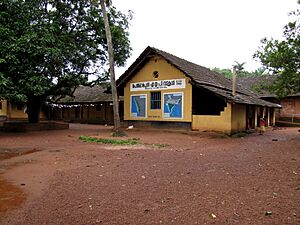
When the British ruled India, Christian missionaries started many schools. These schools became popular and set the standard for modern schooling in India. Today, most schools follow a similar model for teaching and subjects.
Schools in India vary greatly, from large campuses with many students and high fees to small schools where children learn under a tree for free. There are different education boards, like the Central Board for Secondary Education (CBSE). Typical subjects include languages, math, science (physics, chemistry, biology), geography, history, and computer science. Students also do activities like sports, music, and drama.
Schools in Europe
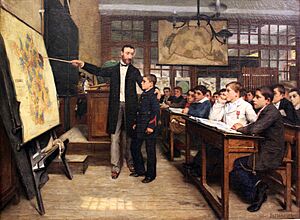
In many parts of Europe, "school" usually refers to primary education (lasting 4 to 9 years) and secondary education. Secondary schools are often split into Gymnasiums (for academic studies) and vocational schools (for job training). The term "school" is rarely used for higher education, except for some "upper" or "high" schools (like Hochschule in Germany), which are colleges and universities.
In Eastern Europe, primary and secondary education are often combined. Schools are classified by "degrees" of education: primary, unfinished secondary, and finished secondary. The first two degrees (eight years) are usually included, and the last one (two years) allows students to go on to vocational or specialized training.
Schools in North America and the United States
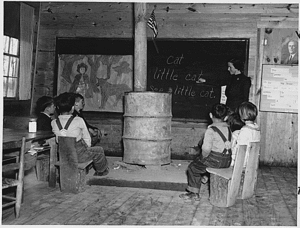
In North America, "school" can mean almost any place of learning. This includes preschool (for very young children), kindergarten, elementary school, middle school (or junior high), high school, college, university, and graduate school.
In the United States, each state's department of education checks how well schools are doing. Charter schools are public schools that have more freedom from some rules. The terms grammar school and grade school are sometimes used for primary schools. There are also magnet schools, which are tax-funded and offer special programs not found in regular schools.
Schools in Africa
In West Africa, "school" can also mean "bush" schools, Quranic schools, or apprenticeships. These include both formal and informal learning.
Bush schools are training camps where cultural skills, traditions, and knowledge are passed down. They are separate from the main community, located in forests. Students stay there until their training is done, and visitors are not allowed. Boys and girls attend separate bush schools. Boys learn crafts, fighting, hunting, and community laws. Girls learn domestic skills like cooking, childcare, and how to be a good wife.
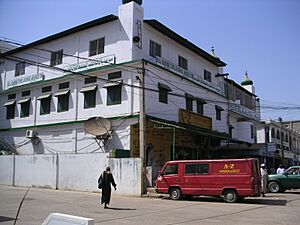
Qur'anic schools are the main way to learn about the Quran and the Islamic faith. They also helped with reading and writing during colonial times. Today, they focus on reading, memorizing, and reciting the Quran. Children often go to both state schools and a Qur'anic school.
In Nigeria, "school" includes daycares, nursery schools, primary schools, secondary schools, and universities. Primary and secondary schools can be privately funded (by religious groups or companies) or government-funded (called public schools). Students spend six years in primary school, three years in junior secondary, and three years in senior secondary. The first nine years of schooling are required. Universities can be funded by the government, religious groups, or private organizations.
Who Owns and Runs Schools?
Many schools are owned or funded by the government. Private schools operate independently. Private schools usually get their money from fees paid by families whose children attend. However, some private schools might also get government help, like through School vouchers. Many private schools are connected to a specific religion and are called parochial schools.
What You Find in Most Schools
Schools are designed for teaching and learning. The most important parts are the classrooms where teachers teach and students learn. Classrooms might be special for certain subjects, like labs for science or workshops for art.
Typical schools also have many other rooms and areas:
- Cafeteria (or dining hall) where students eat lunch, breakfast, and snacks.
- Athletic fields, playgrounds, gyms, or tracks for sports and physical education.
- Schoolyards, often made of concrete, for playing, especially in elementary schools.
- Auditorium or hall for plays, music shows, and school meetings.
- Office where the school's administrative work is done.
- Library where students can ask librarians for help, check out books, and use computers.
- Computer labs for computer work and internet access.
- Areas for cultural activities like games, dance, and music.
School Buildings and Design
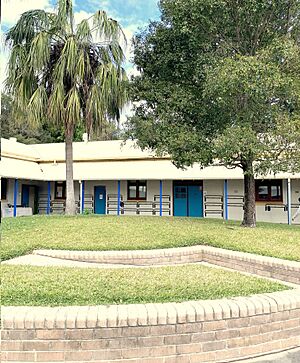
The way school buildings are designed is called educational architecture.
Schools in Lower-Income Countries
In low-income countries, fewer schools have access to basic things. For example, only about 32% of primary schools have electricity. This means less access to the internet, which is only available in 37% of upper secondary schools in low-income countries, compared to 93% in high-income countries.
Access to basic water, sanitation, and hygiene is also not common everywhere. Only about 53% of upper secondary schools in low-income countries have clean drinking water. In high-income countries, almost all schools have these basic services.
Keeping Schools Safe
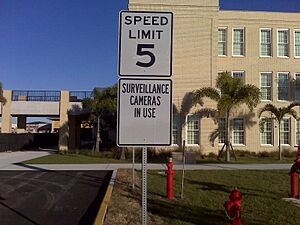
Keeping students and staff safe is a growing concern for schools. Many schools are improving security by adding things like metal detectors or video cameras. Some schools even have students swipe ID cards when they get on the bus. These plans also include numbering doors to help emergency services respond faster.
Other safety concerns include bomb threats, gangs, and vandalism. The United Nations Sustainable Development Goal 4 encourages improving school facilities to create a safe and non-violent learning environment.
Health Services at School
School health services are provided by medical staff, teachers, and other professionals. They work to improve the health and well-being of children and sometimes their families. These services help find, fix, prevent, or lessen diseases, disabilities, and abuse that school-aged children might experience.
Learning Online
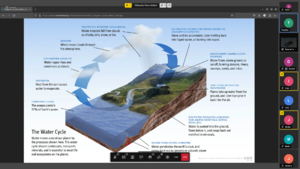
Some schools offer classes online, which means you can learn from home using the internet. Online schools can also help traditional schools. Online classes can give students a head start on a subject. Many online classes cost money, but some are free.
Universities offer many online learning programs. Teachers lead activities and assignments online. Online classes usually follow the same lessons as in-person classes. Students can turn in their work online by deadlines. This allows students to work at their own speed while still meeting requirements. Online classes give students more flexibility to fit learning into their schedules.
One challenge with online classes is not being face-to-face with the teacher or other students. It can also be harder to understand some topics if you can't quickly ask your teacher questions in person. However, online students can use other online resources for assignments or tests. Also, students don't have to leave their house for morning classes or worry about attendance. They can learn at their own pace.
Learning from home is a big reason why many people choose online schooling. Students can attend class anywhere they have a computer – at home, in a library, or while traveling. Online classes are designed to fit a student's needs, allowing them to keep working or handle other responsibilities. Online education is often divided into Online Elementary School, Online Middle School, and Online High School.
Stress in School
Teaching can be a very stressful job in some countries, like the United Kingdom and the United States. This problem is becoming more recognized, and support systems are being created.
Stress can also affect students, sometimes so much that they need medication. This stress is often linked to standardized tests and the pressure to get high scores.
A 2008 study found that eight out of 10 U.S. college students often felt stressed in their daily lives. This was a 20% increase from five years before. Many students also reported feeling sad or had been diagnosed with anxiety or depression.
Rules and Discipline for Students
Schools and teachers often face pressure to cover all the lessons, perform well compared to other schools, and avoid being seen as "soft" on students. Rules about when students can speak, like raising a hand, are put in place to make things more efficient. However, some educators believe these rules don't actually help students learn. They argue that strict rules can even hurt students' dignity and self-worth, which are very important for learning.
|
See also
 In Spanish: Escuela para niños
In Spanish: Escuela para niños
- Bullying in teaching
- Criticism of schooling
- Educational technology
- School pedagogy
- Free education
- Lists of colleges and universities by country
- Lists of schools by country
- List of songs about school
- List of television series about school
- Mobile phone use in schools
- Music school
- Secular education
- School bullying
- School meal
- School story
- School uniform
- School-to-prison pipeline
- Military academy
- Student transport
- Teaching for social justice
- University-preparatory school
- Year-round school
- Night school


